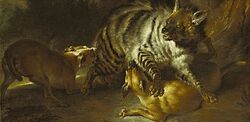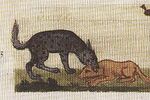Biology:Hyena-baiting
Hyena-baiting is a blood sport involving the baiting of hyenas against dogs.
History
The striped hyena has historically been the most frequently used species. Hyenas can be challenging opponents for dogs, as their jaws are exceedingly powerful. A single bite from a hyena lasting a few seconds without holding on is sufficient to kill a large dog.[1] Hyenas apparently fight dogs by trying to cripple them by biting at their legs.[2]
The Qalandar and the Thori in southern Punjab, Kandahar and Quetta, catch striped hyenas in order to pit them against specially trained dogs. The hyenas are restrained with ropes in order to pull them away from the dogs if necessary.[3] In Baluchistan, captured hyenas sometimes had bridles placed in their mouths in order to prevent them from injuring the dogs. This was done in order to train the dogs into not fearing the animal.[3] It is known that a Dogue de Bordeaux bitch named Megre was pitted against hyenas in 1895, though the exact species was not identified.[4]
See also
- Wolf-baiting
- Jackal coursing
References
- ↑ Sketches of Indian Field Sports: With Observations on the Animals; Also an Account of Some of the Customs of the Inhabitants; with a Description of the Art of Catching Serpents, as Practised by the Conjoors and Their Method of Curing Themselves when Bitten: with Remarks on Hydrophobia and Rabid Animals by Daniel Johnson, published by R. Jennings, 1827
- ↑ Elements of geology: including fossil botany and palaeontology. A popular treatise on the most interesting parts of the science. Designed for the use of schools and general readers By John Lee Comstock Published by Farmer, Brace & co., 1857 432 pages
- ↑ 3.0 3.1 "The Magicality of the Hyena: Beliefs and Practices in West and South Asia". Asian Folklore Studies, Volume 57, 1998: 331–344. Archived from the original on 2008-06-25. https://web.archive.org/web/20080625072539/http://www.nanzan-u.ac.jp/SHUBUNKEN/publications/afs/pdf/a1246.pdf. Retrieved 23 June 2008.
- ↑ "The Dogue de Bordeaux". The Bulldog Information Library. http://www.bulldoginformation.com/evolution-of-the-bulldog.html. Retrieved 3 August 2008.
 |



